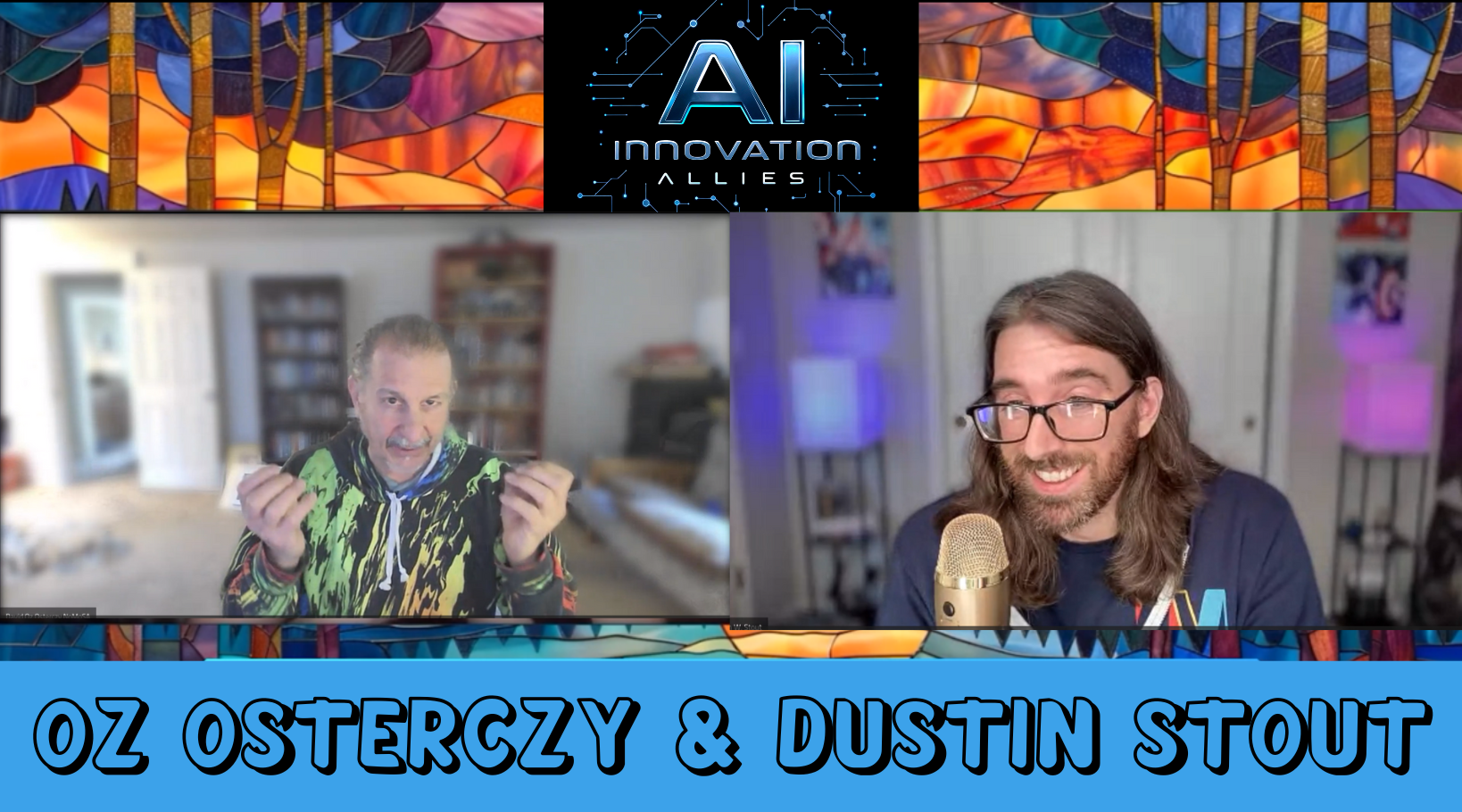AI Innovation Allies Episode 2: How to Create Viral Social Media Posts with AI
—
Intro Music Fades In
Narrator:
“Welcome to AI Innovation Allies, the ultimate hub for cutting-edge AI insights. Join us as we collaborate, innovate, and elevate the world of AI. Oz and the Diva dive deep with AI experts as they share pioneering insights and groundbreaking industry innovations.
Explore our tutorials and reviews to elevate your projects with the latest AI tools and techniques. Discover transformative AI collaborations through compelling case studies and real-world applications. Engage in community challenges, workshops, and webinars designed to fuel your passion for AI.
Stay with us for the latest AI news, updates, and a peek behind the scenes into the dynamic world of AI. Together, let’s shape the future of AI. Subscribe, collaborate, and be part of the revolution!”
[Intro Music Fades Out]
—
Hello everybody! This is Oz & Dustin coming at you again, and we’ve got a good one for you today. We’re going to talk about viral social media writing posts, all right? Built-in Magai exclusively.
So, I am going to share my screen, and Dustin is going to explain what we’re doing. So let me share my screen, and Dustin can take us through, of course, his brilliant—brilliant (don’t have to speak well to be a CEO)—brilliant formula for social media posts. And here we go. Dustin, what are we doing?”
Well, so there’s a lot of people out there I’ve noticed who—I mean, there’s a lot of businesses who don’t exactly know what are the best practices for creating social media content, right? And it’s ever-changing; it’s always different.
I’ve been in the world of social media marketing for long enough to know that yesterday’s best practices are today’s ‘never get seen ever again’ practices. So you always want to know what are the latest trends, what’s actually working in social media. And most of us don’t have personal assistants who can go do all that research for us.
So the great thing about AI, especially the newer models coming out that are enabled with something called deep research, is they have the ability to do a crap ton of real-time research and find those current trends, and then from that, do some things to help us create content that matches those trends.
For someone like me, who does this all the time, it’s fairly obvious, but for the average person, they just may not think to do this. So what we’re going to walk through is just telling the AI to do exactly what we want it to do. We want it to help us figure out how to create viral content based on recent studies, recent data, recent trends.
Recently, we added the Perplexity deep research model into Magai. Perplexity is doing a great job, and they’re creating some really interesting products and putting some really interesting capabilities into these AI models. Their deep research model is a self-contained, research-enabled model. It’s going to take your query, and it’s going to perform multiple different web searches based on your query. It’s going to gather data from all of the different websites that it searches, and it’s going to put all of that data and all of its research into basically like a little research paper for you to learn from. And then from that, you can have the AI build virtually anything you want from that research.
So we’ll start with prompt number one. Our goal here today is to have an assistant that creates viral social media posts for us. So we start with a simple prompt. As you can see on Oz’s screen, he started with the prompt, but he also had, at the time, he enabled Perplexity deep research.
So Oz, if you can maybe click on the model selector and just show that in Magai, we allow you to choose from any of the top models. And the one that he selected at first, because we want to first do this deep research on this topic, was that Perplexity deep research. And so his prompt was fairly simple. It was what I outlined on Facebook for folks. If we can go back to that screen real quick to show the prompt. It says:
*’I want you to research the most current viral social media posting trends for written content and come up with some repeatable formulas based on them.’*
So here’s what we’re doing. We’re telling the AI what we want it to research, and we’re also telling it what we are going to want it to do with that research. So if we don’t sort of guide it in the direction of how it should be thinking about this information and what that end goal is, it may wrap that information differently, and it may not be as effective. So we tell the AI, ‘This is what you’re going to research, and this is what we’re going to use that research for.’
So it did—Oz, I don’t know if you remember—maybe took 60 seconds, maybe a minute and a half sometimes, because it does search a lot of websites. It doesn’t just do the first three or five Google search results; it’s running multiple queries, and it’s going to scrape all the information from those different queries. It’s going to give us a list that it’s now breaking down into formulas, analyzing the formula behind what viral social media posts are working. And now we have all that research, all that juicy information built for us.
And once we have that, from there we go on to the next prompt. Now, obviously, you want to look through this data and research to make sure it seems legit, because again, AI models can make mistakes. They can hallucinate. So you want to kind of audit it just to make sure that you’re putting some human eyes on it, and maybe making some corrections if needed.
But the next prompt is fairly simple as well:
*’Please turn this research into a system prompt for an AI model that will create viral social media posts using these patterns.’*
Now, I should back up a little bit. In Magai, we give you the ability to activate personas. Personas are essentially specialized instructions that the AI is going to follow, and it’s going to dictate how it responds. So that first prompt that we sent, we had Perplexity deep research, and we had the assistant persona. The assistant persona is just meant to be as generally helpful as possible in many different tasks and categories.
But for the second prompt, Oz activated the Claude 3.7 Sonnet persona because I found that to be the best human-like writer. Then we switched over to the Persona Generator persona. This is a persona engineered to help you write system prompts or create persona instructions. Different model for different tasks and also different personas for different tasks.
So with the Claude 3.5 Sonnet model selected and the Persona Generator persona activated, we can give it this prompt:
*’Turn this research into a system prompt for an AI model that will create viral social media posts for us based on the data.’*
So once he sent that off, the model, along with the persona, took all that rich data that it just researched, and it turned it into a set of instructions that he can then create his own custom persona for. And then once you have that system prompt, it’s just a matter of copying the content at the bottom of the message here—we’ll have a copy button where you can, in a single click, copy all the content of that message. And you can see this is a pretty extensive system prompt. It would take many, many hours of learning how to prompt engineer to get those same results.
So you click on the copy button, and once you click on that, you’ll have all that text in your clipboard. You can go over to Magai’s persona section to create a persona that will then be essentially your viral social media post generator—almost like an employee that you’ve hired specifically for this task.
And so it looks like Oz already created his in his Magai workspace. Once you have that persona activated and done, you just start asking it for viral social media post content, and it does exactly that. I’d love to see what your results were from this. Oz, did you give it a try?”
That’s what we’re going to do today! I knew—I did this on the weekend, so I’m like, ‘Okay, I got that meeting with Dustin on Monday. Let’s do it together because I know I’ll just screw it up.’
So the question I have is, you know, what would be a great starting point? Because, of course, every business is going to use this differently, right? They’re going to do research; they’re going to try to figure out, ‘What is the best thing to do? What are the limits of this?’
And, you know, for an organization like mine, which is NoMoSA—No More Starving Artists—you know, we’re looking for investment people to look at what we’re doing, okay? We’re looking for a lot more artists to get this out to, but only in Utah, okay? Because we’re going to be expanding to Texas and then other states, but right now we’re just doing this locally. Of course, we’ll ship all over the country.
But what would you suggest would be—I really want to blow away Christine, who’s my business partner down in Texas, and you know her well. What would be a good starting point for a viral social media post based on what we’re doing right now? Or a viral social media post to bring more people to Magai? Six of one, half a dozen of the other. What would be a good starting point for any business once they have this viral social media generator in their hands? This is, you know, in their ballpark.”
That’s a great question, Oz. And I don’t know why you’re asking me instead of asking the viral post generator! That’s exactly what it’s built for.
All right, that question! Let’s do it!
The whole point of having AI—building custom AIs that do these things for you—is to not have to ask anybody else the question. The goal of it is to answer all those questions for you. So start a new chat—a brand new chat.
Brand new chat? Okay.
Brand new chat. Yeah, you don’t want to dilute it with any of the stuff in this conversation because every piece of context in a conversation influences the output. We want a fresh slate. And you can do that over in the top right corner, the little three-dot menu—oh, well, it was there. Over in that three-dot menu in the top right corner, if you hit it, the menu comes out. The first thing on the top is ‘New,’ and that will allow you to start a new conversation without having to reload the page.
Got it. Okay.
So, one of my—for everybody else to know—yeah, so you’ve got Claude 3.5 Sonnet, you’ve got the Viral Post Generator persona activated, so all you really need to do is just start talking.
All right, so Claude 3.5 is good? Why not 3.7?
3.7 is good also. 3.7 just tends to be a little more comprehensive or verbose. But for this one, I actually would go with 3.7 Sonnet because you’re essentially starting fresh and you’re going to be in a brainstorming phase because you want to ask it the question and analyze that question. So yeah, just stick with what you got there—yep, 3.7—and ask it exactly what you asked me.
Here is what my business is. What viral posts would you suggest?
Now, I’ll actually stop you there, Oz. What workspace are you in right now?
What workspace? Mm-hmm.
Are you in—?
I am in David’s Brand.
Okay. Second question: Does David’s Brand’s workspace have all of the custom context that involves your business? Have you added any custom—?
No, that would be NoMoSA.
Okay, so I would switch over to NoMoSA, and so it has context built in about what your business is, who your target audience is?
Yeah, Christine and I built it all into this.
Perfect. So instead of writing all that stuff out and typing all that stuff out for the AI, just say, ‘What are some social media posts you suggest for me?’ And this is exactly why I built Magai the way that I did, for the simple fact that you can preload a lot of the information and context you need so that the AI already knows it. You don’t have to tell it every single time—that’s what workspaces are for.
So if you’ve done everything right, it’s going to go ahead and just suggest all kinds of posts for you based on all that data that it already has about you.
Wow! This is so fast; it’s ridiculous.
Now, that was just the simplest of simple requests, right? And you can go through and you can kind of evaluate whether or not they’re actually good. Let’s do a follow-up, okay? Let’s do a follow-up and say, ‘Build me a content calendar for an entire month’s worth of content in a table format.’
Build a what? Build me a content calendar?
Yes, ‘Build me a content calendar for an entire month’s worth of content in a table format,’ and hit enter.
Now, one of the things AI is also great at is building spreadsheets, and it does it right inside the message for you. So we’re going to watch Claude 3.7 knock out an entire month’s worth of content in probably about 30 seconds.
Oh my god!
I’m going to have you do one more thing, Oz. In the right sidebar of your page, if you expand it out, and then that top button—the three dots—click on that guy and go down to where it says ‘Wide.’ It’s the second-to-last option right there. Yep, hit ‘Wide,’ and that way we can see this table a little bit better.
I’m not going to bother scrolling up; I’m just going to let it do its thing.
Yeah, let it finish, and then we’ll go scroll through what it created. And here’s what I love about 3.7 Sonnet: it is a reasoning model; it’s a thinking model. And so it really thinks through the scenarios, and it’s going to give you a lot of extra stuff.
That’s why I say, you know, sometimes you only need 3.5 because 3.5 is a little less verbose; it’s going to be a little less comprehensive. Sometimes you just need some quick text output; you don’t need all the preamble or the explanation afterwards. But if you really want it to be thorough, 3.7 Sonnet is the way to go.
And look at this—it’s got suggested times when to post. It’s giving you week-by-week suggested hashtags, platforms—I mean, it gave you everything you needed in 30 seconds for an entire month’s worth of content.
Unbelievable! Unbelievable! Yeah, I’m going to play with this a little bit more. This is incredible. Christine’s going to lose her mind. She’s got to go, ‘Teach me how to do this!’
And at that point, all you have to do is use your drag-and-drop to select the whole table. This is what I do. And you can just open up a spreadsheet in another tab, like a Google Sheet, and you can just copy and paste that whole table into a Google Sheet, and then you have it in a spreadsheet format.
Incredible. And there’s an entire month. And if I asked it to do—well, I don’t think I’d ever ask it to do an entire year because trends do change—but this is incredible. Now, I’m noticing that it’s doing just one LinkedIn a week. I’d like it more likely to do three. So I’m just going to type in, ‘This is great. Now, please include’—and of course, you’re going to change what I’m saying—’LinkedIn posts three times per week with best days and times to post.’
Perfect. I have no notes.
Yeah, I really believe that, you know, since we’re B2B right now, we’re not going to find too many of our clients on Facebook or Instagram; it’s going to be LinkedIn. Twitter—I’m not even sure we’re going to use right now for some pretty obvious reasons. But let’s see—is it just doing—alright, it’s including Twitter and Instagram. Great. And it’s doing more LinkedIn. This is exactly what I wanted it to do.
So hopefully, it’s giving the same information as above, but I’m going to send this all to Christine. I can’t even begin to think of how much time this would save.
Now, if we used ChatGPT, would it also include—if we asked it to—images with DALL·E 3?
You could ask it for images with DALL·E 3, although I would never wish that upon anyone.
Yeah, well, DALL·E 3—I mean, I mostly use it for art, you know, for creating different ideas. If your target audience appreciates abstract art or, you know, impressionistic art or anything that’s super artistic type of art—non-photorealistic art—then DALL·E is pretty sufficient; it can do the job. But, you know, for me and most of the people I talk to on a daily basis, they want photorealism, and DALL·E is just not going to give you that.
But because Magai gives you access to all of these different AI image generators—including Flux, which is—Flux is amazing, especially when you’re adding any text to the image—so, you know, it makes it super easy. From this same dialogue, you can type in, you know, in the prompt there, you can say, ‘Create an image for me based on the first post.’ You can make simple—
Can you only do it one post at a time?
You can only generate one image at a time, so you take it piece by piece.
Alright, so with Flux—it’s going to do Flux by default because currently, that’s the only model that it has access to. Soon enough, you’ll be able to say ‘with Flux’ or ‘with DALL·E’ or ‘with Leonardo’ eventually. We’re still working on that, but right now, it’s going to do Flux by default. You can specify a size if you want it to be in landscape size, portrait size, or square size.
Let’s see. Let’s just go with the first LinkedIn post. Alright, so ‘Create an image for me based on the first LinkedIn post.’ And it will automatically know the optimal size for LinkedIn?”
No, you have to specify what size you want it to be in.
Ah, let’s see what it creates. Oh, it went away.
Give it a second. Sometimes it flashes.
Yeah, it just showed it, and then it went bye-bye. Wow, that’s really good! A little glitch with the teeth there, but you know, it’s going to be so much smaller on LinkedIn. One, two, three, four—I’m always counting fingers. It just blows me away because Flux generally gets it right. This one’s a little weird, but again, it’s good enough. The faces are really good. Love the guy’s hair. He’s got great hair!
It’s great hair. I love that hairdo.
Yeah. Alright, this is outstanding! Oh man, Dustin, this was—I just—it’s funny because when I was speaking to Daniel Knight from Unicorn Universe, you know, he just talked about how smart you are, and you said the same thing about him. Yeah, there’s just so much out there, and I really would hope that the people that are kind of afraid of AI and wondering if it’s going to take over the world understand that in so many positive ways, it’s so unlimited, and they can help their businesses and a lot of the people around them out so much to save such an immense amount of time.
I mean, what you just showed me—the simplicity of it—is incredible. And I thank you from the bottom of my heart for creating Magai, and I will continue to send people to you because I know that just about every business could use the information here. And please keep teaching. You know, we’re going to be posting all this up on our page on YouTube—which you guys are on right now, okay, when we post this. But thank you again. I just—my brain is in 10,000 places right now thinking about all the possibilities for this, and I have to stop over-explaining it or making it so much more detailed because the AI really does everything if you just give it simple, simple directions.
Well, yes, it’s a combination of simple directions in the right context, right? Because you had a workspace where you preloaded it with all the information it needs about your business. That’s why you can make a prompt as simple as you did. Otherwise, your prompt would have had to be super detailed; you would have had to add all that extra business context or personal context every single time in a new conversation because these other apps only give you sort of one way to layer in context.
Whereas Magai gives you several and very specific ways to do that, so your outputs are far more intelligent, and you can use way simpler language. And even if you wanted to sort of beef up your prompts, we do have that ‘Prompt Enhance’ button built into the chat prompt where you could have had the AI engineer those simple prompts for you and maybe get some added juice out of them that you may not have thought of. But as we saw demonstrated, simple prompts work just fine with the right persona and the right context.
You’re killing me, Smalls! Dustin, thank you again, and we’re going to stop the recording now, and we’ll see you guys again soon.”
—




